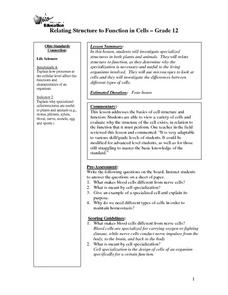Curated OER
What Is Life?
In this life characteristics worksheet, students answer 16 questions about living things, Redi's experiment, basic needs, growth and development.
Curated OER
Digestion and Nutrition
In this digestion worksheet, students will review a diagram showing the parts of the digestive system and the length of the intestines. Students will complete 3 short answer questions based on the diagram.
Virginia Department of Education
Osmosis, Diffusion, and Active Transport
No, it really is okay to play with your food! Emerging scientists manipulate popcorn, eggs, and other household objects as they demonstrate multiple cellular processes. The activity, capable of modifications, is designed to reflect the...
University of Minnesota
What's the Deal? Addiction Card Game
Addiction is a big deal! Playing a game of cards helps learners understand the concept of addiction. Through their analysis, they examine the potential for addiction and how it varies for each individual.
Virginia Department of Education
The Ratio of Surface Area to Volume
Demonstrate the ratio of surface area to volume in your high school class by using phenolphthalein, gelatin, and an onion. Intrigue the class by leading a discussion on osmosis and diffusion, then making "scientific jello." Participants...
Curated OER
Protection, Support, and Locomotion
In this vertebrate skeleton worksheet, middle schoolers will read a paragraph about the function of bones, muscles, and skin. Then students will complete 6 short answer questions.
Curated OER
Respiration, Circulation, and Excretion
In this body systems activity, students read information about the respiratory, circulatory, and urinary system and then complete 5 short answer questions.
Curated OER
The Respiratory System
In this respiratory system instructional activity, students review how the air passageways and lungs transport oxygen through the respiratory system. Students also review the mechanics of breathing. This instructional activity has 6...
Curated OER
Community Distribution
In this community worksheet, students read the definitions of primary and secondary succession and then choose a picture for each as an example. Students complete 1 true or false and 2 short answer questions.
Curated OER
ATP in a Molecule
In this cell energy worksheet, students review how ATP is formed and broken down and the uses of cell energy. This worksheet has 8 fill in the blank and 2 short answer questions.
Curated OER
Making Connections
In this experimentation worksheet, students review the steps of setting up an experiment, determining the correct procedure and analyzing the data. This worksheet has 23 fill in the blank questions.
Curated OER
Oxidation Numbers
In this oxidation numbers worksheet, students compare metals and nonmetals, draw Lewis Dot Diagrams, and determine the oxidation number for the given elements. This worksheet has 1 multiple choice, 5 short answer, and 12 fill in the...
Curated OER
Animal Kingdom: Phylum Chordata
Students use a dichotomous key to classify various vertebrate jar speciments into classes. They examine the speciments for general characteristics of each class and fill in a corresponding chart and then complete a few final assessment...
Open Oregon Educational Resources
General Biology I: Survey of Cellular Biology (Mt Hood Community College Biology 101)
From the scientific method to the function of a cell, the eBook has it all. A useful resource provides a free biology textbook with a focus on context. The text begins with an overview of the process of scientific inquiry and biology...
Curated OER
Relating Structure to Function in Cells
Twelfth graders investigate specialized structures in both plants and animals. They relate structure to function, as they determine why the specialization is necessary and useful to the living organisms involved. They use microscopes...
Curated OER
The Jelly Bean Problem
Students are challenged to eat some candy as a cell would need to do it. By solving this problem students simulate the cell process called endocytosis. They think about some of the problems that arise when a cell ingests food.
Curated OER
Observing Osmosis in a Chicken Egg
Tenth graders develop a hypothesis and explain what they observed on an activity. In this investigative lesson plan students observe osmosis and report their data using a graph.
Curated OER
The Senses
For this senses worksheet, students use the terms listed on the eye to label the figure and describe how light entering the eye becomes an image seen. Then they name the three main sections of the ear and explain what the cochlea does.
Curated OER
The Senses
In this senses worksheet, high schoolers use a text book to complete 34 fill in the blank statements about the structures and functions associated with the 5 senses.
Curated OER
Disease Hits Home
Students are provided with the name of a disease, and using library and internet facilities, are asked to explore and explain the route of transmission of this disease in their specific case study. Familiar diseases are then categorized...
Curated OER
Blood Business
Students identify the different kinds of blood. In this biology lesson, students investigate the antigens, agglutinins and Rh factor using their own blood. They use Punnett squares to predict blood type of offspring.






















